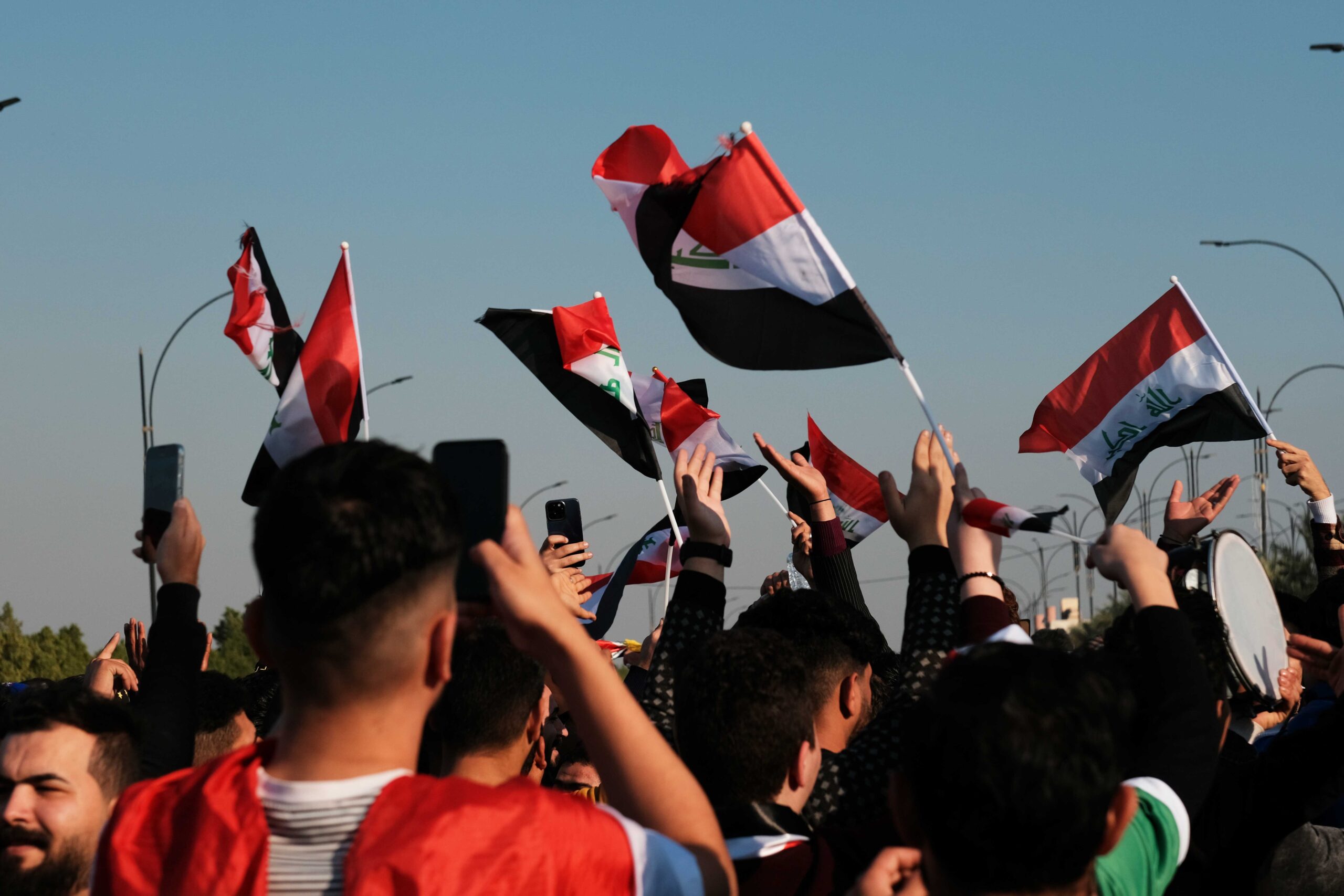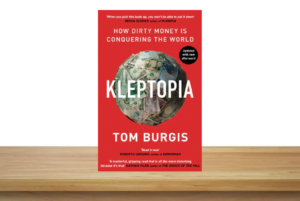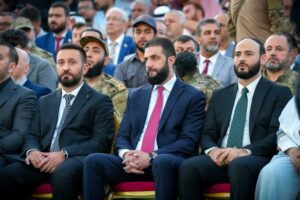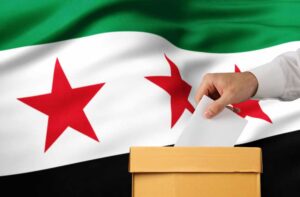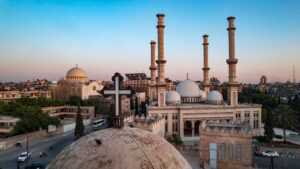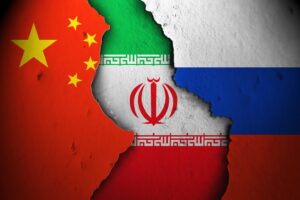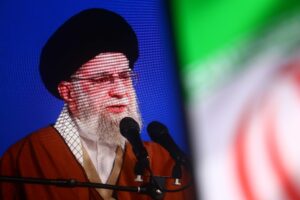As Iraq looks back at the past decade, the “Arab Spring” is seldom the primary point of reference. In my observations, Iraqis have a very different—though not less dramatic—lived experience. While Iraq’s youth have also rebelled against authoritarian and dysfunctional governments, the Arab Spring also loosened the forces that inflicted the incredible pain and suffering on the Iraqi people beforehand—minorities and Shi’a Arabs in particular. The Iraqi experience then moves not in parallel with those of the rest of the region, but almost orthogonal to it. Put simply, because Iraq’s political system is so different from the authoritarian dictatorships of its Arab neighbors[i], the Arab Spring—based around an anti-authoritarian message—impacted Iraq very differently. This lack of shared experiences provides further explanation for Iraq’s continued separation from the rest of the Arab-speaking world—despite attempts on both sides to close the gap.
In many ways, Iraq simply lacked the bandwidth to pay serious attention to events and their implications outside its own borders. When the Tunisian Mohamed Bouazizi famously self-immolated on the streets of Sidi Bouzid, Iraq had just resolved their own “Bush v. Gore”-style 2010 parliamentary election. This reluctant agreement would eventually seat Nouri al-Maliki in his second Prime Ministerial term after eight months of internal wrangling.[ii] Baghdad would then immediately be engulfed in the debate over the pending U.S. departure from Iraq, in compliance with the “Withdrawal Agreement” signed by Ambassador Ryan Crocker during the Bush Administration.[iii] This, of course, ended with the eventual departure of U.S. forces at the end of 2011.
While there would be a February 25, 2011 “Day of Rage,” protesting primarily the lack of essential services (in the Iraqi context, almost always electricity and water), the spirit of this protest quickly died after the killing of over twenty demonstrators, primarily in the Sunni and Kurdish north.[iv] Setting Iraq apart from the rest of the region, the most notable and long-lasting demonstrations of 2011 were directed at Saudi Arabia for its intervention in Bahrain, in which Saudi forces rescued the allied Sunni-minority government from the uprising of its Shi’a majority population.[v]
Hence, the momentum of the Arab Spring largely bypassed Iraq, at least in the inspiring and straightforward ways that Tunisia and Egypt experienced. While a relationship of causality is difficult, if not impossible, to prove, in addition to the events discussed above, one can speculate that the invasion, occupation and civil war of the prior decade tempered the enthusiasm of the moment, as did the admittedly imperfect representational nature of governance in the state. The muhasasa system, dividing power and patronage between the various political parties, which initially promised a solution to Iraq’s ethno-sectarian divide, had long since shown its dysfunction.[vi]
Sectarian in spirit
The demands of the protests’ leaders were, in turn, extremely sectarian, focused on the demands of the country’s Sunni Arab minority.
Iraq’s anti-government demonstrations erupted in 2012, but these were limited to the Sunni Arab areas. Less about democracy, the sentiment of these protests could be fairly characterized as revanchist. The sites of protests—particularly in Ramadi—were populated by Baathist, Al Qaeda and ISIS flags, with frequent derogatory references made to Shi’a Arabs as “majus” and “Safavid.”[vii] The demands of the protests’ leaders were, in turn, extremely sectarian, focused on the demands of the country’s Sunni Arab minority. While some of the grievances against the Maliki government were legitimate, the protests quickly turned into a questioning of fundamental state legitimacy.[viii] In this climate, even reasonable objectives like prison reform and the repeal of sweeping security laws were accompanied by utterly unrealistic demands, such as that of recruiting over half of Iraq’s security forces from the Sunni population, and that de-Baathification be repealed wholesale, rather than reformed.[ix]
Particularly problematic, the protests in Mosul were organized by the explicitly neo-Baathist JRTN (Jaysh Rijal al-Tariqa al-Naqshibandi), which would later seek to band with ISIS in the latter’s 2014 “liberation” of Mosul, before eventually being subsumed—or rather purged—by ISIS.[x] Connections with the prior regime deeply tarnished this round of protests in the eyes of Iraq’s non-Arab Sunni populaces—Arab Shia, Kurds, and the minorities. Whether looking at the Sunni-supremacist Ba’athist past, or a Sunni-supremacist Islamist future, these protests held little attraction for the majority of Iraq’s citizenry.
Therefore, rather than being seen as part of the currents of the Arab Spring, these early protests could instead be framed as a reaction against the spirit of Arab Spring. Such protests had far more in common with the anti-Morsi coup, an attempt to return to the status quo ante, than the rejection of authoritarianism that characterized the Arab Spring by large.
A reactionary movement
Iraq’s next interaction with the Arab Spring would be a negative one. The space – both literal and metaphorical – provided by the Arab Spring-inspired Syrian Civil War permitted the incubation of ISIS in eastern Syria.[xi] Absent the chaos of revolutionary Syria, it is hard to picture ISIS having the sanctuary to constitute itself as it did before its spectacular, if tragic, return to Iraq. So in this sense, Iraq paid a high price for the Arab Spring taking on in Syria.
Protests in Iraq were largely overshadowed by the arrival of ISIS. The group first took over Fallujah in January of 2014 (immediately following, and presumably in response to, the dismantling of a protest camp by the government, further emphasizing the interlinkage between ISIS and this wave of protests) and then much of northern and western Iraq in June of the same year. The battles that followed – waged between Iraqi security forces, including the Popular Mobilization Forces (PMU), or Hashd[xii], and the anti-ISIS coalition – occupied not only Iraq’s attention but also captivated the world. While the Iraqi government claimed victory in December 2017, many assets of the anti-ISIS coalition did not leave Iraq until 2019-20.
Towards qualitative rather than wholesale regime change
Services and corruption were always at the forefront, rather than political parties and the system of governance itself.
However, anti-ISIS fights did not prevent a new wave of protests from emerging, albeit primarily in the Shi’a Arab south, far from the fighting. The late Falah Jabar would characterize the 2015-18 protests as “mainly directed against political Islam.”[xiii] This is true, but always at one remove, as services and corruption were always at the forefront, rather than political parties and the system of governance itself. These protests all occurred in the summer and particularly in the hotter south, when differences between the government-supplied electricity and water and consumer demand for the same were most acute.
2016, in particular, would be marked by the Sadrist protests, which—as the later 2019 protests would fully display—represented a unique sub-group within the larger protest movement. In April and May of 2016, when the Council of Representatives was unable to assemble a quorum to vote on proposed government shakeup to appease critics (changing in a few Ministers), Iraqis aligned with the Sadrist trend assembled in Baghdad. Setting up an improvised tent city inside the secured government area known as the “Green Zone,” several thousand lower-class Iraqis simply stayed in place to put pressure on the government. While this protest was certainly directed at broader themes concerning services and corruption, it had a distinctly partisan flavor to it, in this sense a perverse descendant of the 2012-13 Sunni protests.
The 2018 protests continued the focus on infrastructure. Again, concentrated mostly in the south (primarily the city of Basra) the protests were centered around the issue of services: the lack of power and water during a particularly hot summer.[xiv] These protests had a less partisan atmosphere and referenced government failure too, though clearly triggered by a particularly tangible deprivation in everyday life.[xv]
A grassroots political movement
Drawn from the youth of Iraq’s Shia Arab majority, but speaking for the aspirations of the state as a whole, the protesters demanded a nationalist, non-sectarian, non-corrupt government responsive to popular will.
Iraqi voices again emerged in protest in Baghdad in October of 2019. But these protests were of an entirely different kind than the earlier Anbar and Hawija protests.[xvi] Disconnected from the heat of summer, they were not the infrastructure focused demonstrations of 2015-2018 either. Drawn from the youth of Iraq’s Shia Arab majority, but speaking for the aspirations of the state as a whole, the protesters demanded a “watan,” or homeland, from their political class. In other words, a nationalist, non-sectarian, non-corrupt government responsive to popular will. While occasionally sub-sets of the demonstrators made explicit demands for jobs or other tangible benefits, as a whole, the movement was extremely altruistic. Attacking the ethno-sectarian spoils system (muhasasa) and the endemic corruption it had produced, these demonstrations—while somewhat naïve in their demands—seemed the closest to carrying the Arab Spring spirit, albeit in a very different sense.
The response to these protests has been twofold. At first glance, the most surprising was perhaps the response of the government to protesters and the level of violence that accompanied their suppression. More than one commentator noted the willingness of a Shi’a majority government to violently suppress a largely Shi’a movement.[xvii] But again, if one recalls the protests as being primarily about “political Islam,” then the government’s use of lethal force (operationalized primarily not by the Hashd so as to maintain deniability) becomes a much more plausible development, considering the Hashd-affiliated Fatah party’s overbearing control.
After several widely covered and admired months, the protests fizzled out. This was likely due to a combination of the use of violence (both mass shootings and targeted kidnappings), Covid-19, and a lack of tangible progress.
The Iraqi democracy
Of course, the moderating factor that makes Iraq’s “Arab Spring” distinct from other Arab countries is the presence of elections, however flawed the results. The elections currently scheduled for October 2021 could be taken as an opportunity to vote for parties whose agenda was inspired by the protests, or at the very least, vote out the parties associated with “political Islam.”[xviii] It will be interesting to observe whether incremental change that began to disempower the parties most connected with the repression of the protests will be sufficient for at least a sizable minority of protestors to be represented in the Assembly. Convincing any major faction of the protest movement to work within the system to reform it may be the best hope for Iraq escaping the sclerotic system of corruption and patronage that have come to define its nominal democracy. Harnessing the energy and, more importantly, the notable numbers that Iraq’s youth population makes up, presents a real opportunity for reform, should a political movement find a practical way to harness it.
If this year’s elections are unable to deliver a significant electoral step towards a better future for Iraq, it is reasonable to expect a continuation of demonstrations. In addition, protests in Baghdad and Iraq’s south could easily be matched by protests in the Kurdish north. It is in the conditions in the three provinces of the KRI, with de-facto single party governance in each province, that one most closely sees, in Iraq, the authoritarianism that inspired the original Arab Spring. While the impressive security state in the north has so far prevented significant public expressions of discontent, it is far from impossible that such could emerge.
Conclusion
Iraq has experienced a decade of protests, but they appear to be on their own path, only loosely related to broader trends in the MENA region. Iraq’s recent history of war, sanctions, occupation and ISIS have doubtless given its citizenry a much different outlook than states that—for all their differences—have had a similar experience of straightforward authoritarian repression over the past decades.
For all its faults and failures, Iraq has a system of democratic institutions and elections.
Ten years after the Arab Spring was ignited, Iraq is simply in a different place than the rest of the region. For all its faults and failures, Iraq has a system of democratic institutions and elections, the results of which do matter. While there are plenty of issues to place on the flag of protests about the system that has emerged, it gives a fundamentally different character to popular movements when the government has at least nominal democratic legitimacy and there is—however imperfectly—an electoral mechanism through which to implement change. How the aspirations of Iraq’s youth interact with these clunky institutions will be defining for Iraq’s second decade following the Arab Spring.
[i] Lebanon being the exception that proves the rule.
[ii] John Leland and Jack Healy, “After Months, Iraqi Lawmakers Approve a Government, “The New York Times, Dec 21 2010. https://www.nytimes.com/2010/12/22/world/middleeast/22iraq.html
[iii] “Agreement Between the United States of America and the Republic of Iraq On the Withdrawal of United States Forces from Iraq and the Organization of Their Activities during Their Temporary Presence in Iraq,” https://graphics8.nytimes.com/packages/pdf/world/20081119_SOFA_FINAL_AGREED_TEXT.pdf
[iv] Stephanie McCrummen, “23 Killed in Iraq’s ‘Day of Rage’ Protests,” The Washington Post, February 25, 2011. https://www.washingtonpost.com/world/13-killed-in-iraqs-day-of-rage-protests/2011/02/25/ABJOv6I_story.html
[v] Mushtaq Mohammed, “Iraq Shi’ites Rally Against Saudi Troops in Bahrain,” Reuters, March 17, 2011. https://www.reuters.com/article/us-bahrain-protests-iraq-idUSTRE72G34H20110317
[vi] Arwa Ibrahim, “Muhasasa, the Political System Reviled by Iraqi Protesters,” AlJazeera, 4 Dec 2019. https://www.aljazeera.com/news/2019/12/4/muhasasa-the-political-system-reviled-by-iraqi-protesters
[vii] “Baath Leader Urges Sunnis to Protest Iraqi Premier,” The New York Times, January 5, 2013. https://www.nytimes.com/2013/01/06/world/middleeast/baath-party-leader-encourages-sunni-protests-in-iraq.html
[viii] Joel Wing, “Understanding Iraq’s Protest Movements, An Interview With Kirk H. Sowell, Editor of Inside Iraqi Politics,” Musings on Iraq, May 7, 2013. https://musingsoniraq.blogspot.com/2013/05/understanding-iraqs-protest-movements.html
[ix] Ibid.
[x] Mapping Militant Organizations. “Jaysh Rijal al-Tariq al-Naqshabandia.” Stanford University. Last modified April 2019. https://cisac.fsi.stanford.edu/mappingmilitants/profiles/jrtn
[xi] Douglas A. Ollivant and Brian Fishman, “State Of Jihad: The Reality Of The Islamic State In Iraq And Syria,” War on the Rocks, May 21, 2014. https://warontherocks.com/2014/05/state-of-jihad-the-reality-of-the-islamic-state-in-iraq-and-syria/
[xii] These terms both refer to the phenomenon often referred to as “Shi’a militias,” the often unorganized or loosely organized volunteer units that flocked to the front lines against ISIS in the wake of the 2014 Fatwah by Grand Ayatollah Sistani. Some of these groups had—and have—significant ties to the Islamist political parties in Iraq and/or their Iranian backers. See Erica Gaston and Douglas Ollivant, U.S.-Iran Proxy Competition in Iraq, New America, Feb 10, 2020. https://www.newamerica.org/international-security/reports/us-iran-proxy-competition-iraq/
[xiii] Faleh A. Jabar, The Iraqi Protest Movement: From Identity Politics to Issue Politics, LSE Middle East Centre Paper Series, 25, June 2018. http://eprints.lse.ac.uk/88294/1/Faleh_Iraqi%20Protest%20Movement_Published_English.pdf
[xiv] Benedict Robin-D’Cruz, “Protests Are Mounting in Iraq. Why?” The Washington Post, July 21 2018. https://www.washingtonpost.com/news/monkey-cage/wp/2018/07/21/protests-are-mounting-in-iraq-why/
[xv] Douglas A. Ollivant, “Summer Is Coming: The Crucible for the New Iraqi Government,” War on the Rocks, Jan 16 2019. https://warontherocks.com/2019/01/summer-is-coming-the-crucible-for-the-new-iraqi-government/
[xvi] Douglas A. Ollivant, “Why Washington Should Side with the Protesters in Iraq,” The Washington Post, Nov 5, 2019. https://www.washingtonpost.com/opinions/2019/11/05/why-washington-should-side-with-protesters-iraq/
[xvii] Alissa J. Rubin, “Iraq in Worst Political Crisis in Years as Death Toll Mounts From Protests,” The New York Times, Dec. 21, 2019 (updated Dec. 24, 2019). https://www.nytimes.com/2019/12/21/world/middleeast/Iraq-protests-Iran.html
[xviii] “Iraqi cabinet votes to delay general election until October 10,” AlJazeera, Jan 19 2021. https://www.aljazeera.com/news/2021/1/19/iraqi-cabinet-votes-to-delay-general-election-until-october-10

